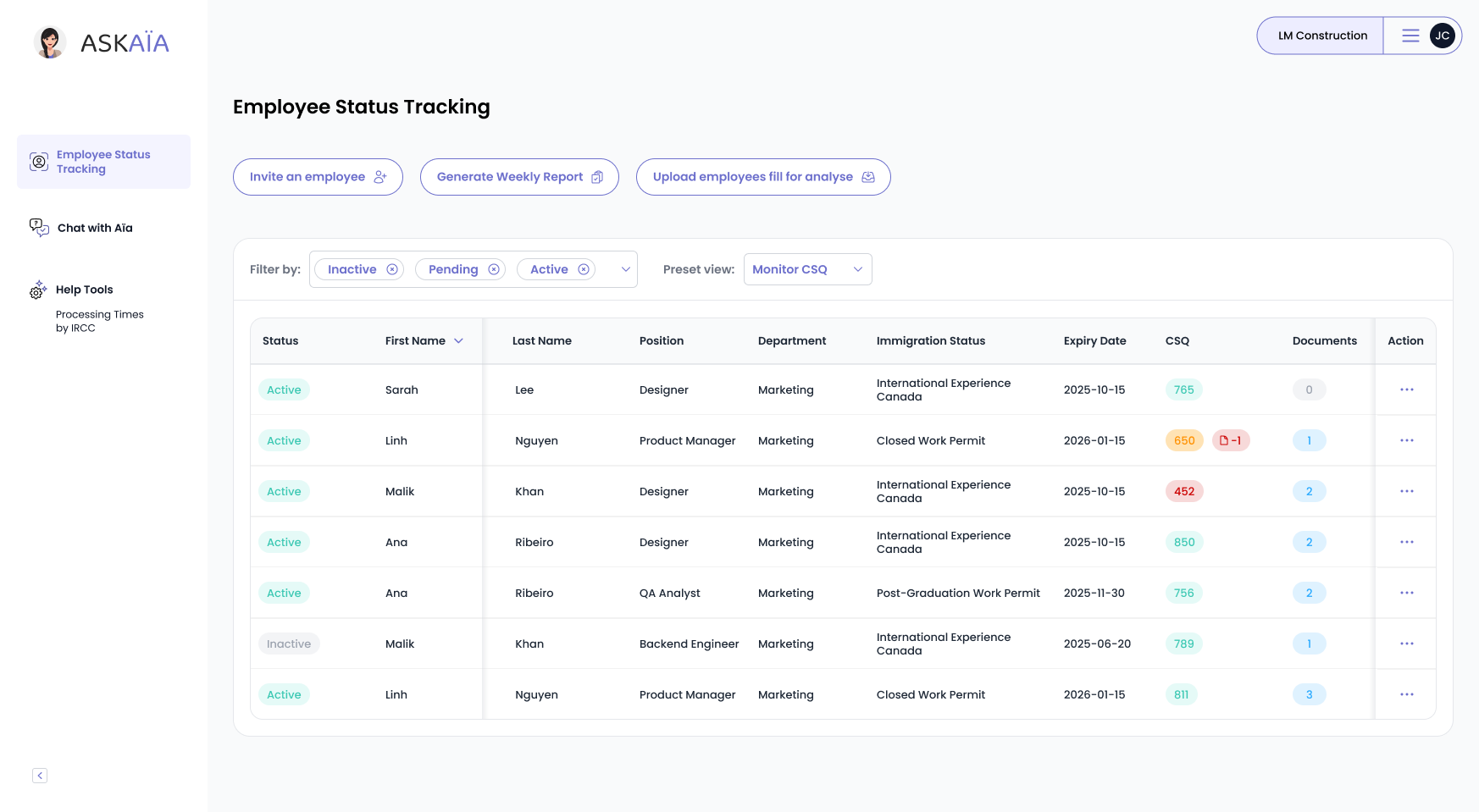LMIA File Prep 2025: Documents, Proof & Transition Plans Explained

Posting the job is only half the LMIA battle. For HR teams, most rejections happen when the file is incomplete: missing documents, vague transition plans, or new 2025 rule violations. Service Canada now reviews LMIA files more aggressively, making full documentation critical.
This article explains exactly what HR must include in the LMIA file, how transition plans work, and which 2024–25 rule changes could stop your application before it even starts.
What you will find in this article
Why LMIA File Preparation Is Where Most Applications Fail
Recent data shows how serious LMIA file preparation failures have become. Between April and September 2024, Employment and Social Development Canada (ESDC) conducted 649 employer compliance inspections. 11% of those inspections found employers non-compliant, resulting in over $2.1 million in fines, more than double compared to the same period in 2023. Additionally, 20 employers were banned from the program, a fivefold increase from the year before.
Every LMIA is a compliance package. Service Canada isn’t just reviewing your candidate, they’re evaluating whether your company followed every rule, documented every step, and can justify each hiring decision.
Failure to include one required document can result in:
- Immediate refusal
- Lengthy requests for additional information (RFI)
- Costly re-filings
- Compliance flags that impact future applications
The LMIA Document Checklist (2025 Version)
Before you submit your LMIA application, Service Canada expects a fully organized and verifiable file. HR teams must approach file preparation as a legal audit package, not simple paperwork.
- Core Application Forms:
- Completed LMIA application form (EMP5627 or EMP5626 depending on stream)
- LMIA processing fee receipt ($1,000 per position)
- Business Legitimacy Documents:
- Certificate of Incorporation or business registration
- CRA business number
- Recent tax filings (T2, GST/HST returns)
- Current financial statements (balance sheet & income statement)
Note: Since October 2024, lawyer or accountant letters of attestation are no longer accepted. Business legitimacy must be proven directly with corporate documents.
- Recruitment Evidence:
- Full job ad text used for all postings
- Screenshots or PDFs of postings with date stamps
- Payment receipts for job boards or media placements
- Summary of Canadian applicants interviewed/rejected
- Wage Compliance Proof:
- Wage breakdown matching median provincial wage
- Bonus/benefit explanation if applicable
- Work Location Evidence:
- Lease agreements or proof of business premises
- Lease agreements or proof of business premises
- Employment Contract (Draft for candidate):
- Full employment offer outlining terms, duties, compensation
- Full employment offer outlining terms, duties, compensation
Transition Plan Requirements (High-Wage Stream)
For high-wage LMIAs, where wage thresholds have recently shifted due to the 20% increase in 2024, employers must submit a transition plan that shows how they intend to reduce reliance on foreign workers long term.Service Canada expects:
- Clear timelines for training Canadian or permanent resident workers
- Internal promotion pathways
- Partnerships with training or apprenticeship programs
- Description of labour shortages in the occupation
Weak plans like “We will advertise locally” or “We will try to hire Canadians” often trigger RFIs or refusals.
New 2024-25 Rule Changes Affecting LMIA Files
As regulations continue to evolve, HR teams must closely track annual LMIA rule changes that directly impact documentation and eligibility. The following updates are particularly important for LMIA file preparation in 2025:
| Rule Change | Impact on LMIA File Preparation |
| Ban on lawyer/CPA attestations (Oct 2024) | Business legitimacy must be proven directly with tax & corporate filings |
| Wage threshold increase (Nov 2024) | Wage calculations must reflect new median wage tables |
| Low-wage moratoriums (2024-2025) | Files for low-wage roles in certain regions — including census metropolitan areas with unemployment rates of 6% or higher — may be automatically refused, particularly in cities like Montréal and Laval. |
| More audit triggers (2025) | Incomplete files increase audit likelihood after approval |
Compliance Audit Readiness: The 6-Year Rule
These enforcement trends underscore the growing importance of full audit readiness. With compliance penalties sharply rising, HR teams must build audit-proof LMIA files from the start.
Even after approval, employers remain under audit risk for 6 years. HR must retain:
- Full LMIA application package
- Recruitment files
- Proof of wage payments
- Work schedules
- Employee records
Failure to provide these documents during an audit can result in serious consequences for the employer, including:
- Fines up to $100,000 per violation
- Program bans that may last from 1 to 5 years depending on the severity and frequency of the violations. In extreme cases, permanent bans may be imposed for repeated or fraudulent non-compliance.
- Public listing as a non-compliant employer
Start LMIA File Prep Early, Not After Ads End
Building a compliant LMIA file isn’t paperwork, it’s risk management. The strongest LMIA applications are built from day one of recruitment, with every document gathered in real-time.
Don’t wait until submission day to organize your file. Book a free consultation with our team to plan your next hire.

Let’s get your demo started
Book a demo
You May Also Like
These Related Stories

After Approval: LMIA Compliance and the 6-Year Audit Rule (2025)
Getting an LMIA approved is a win, but it’s not the finish line. For HR teams, the true compliance challenge begins after the foreign worker is hired. …

Act Now: Canada Widens Low-Wage LMIA Ban Across 26 CMAs
At a Glance " \n Effective July 11, 2025, low-wage LMIA applications are banned in 26 urban regions, including Toronto, Vancouver, Calgary, and Montre …

LMIA Streams 2025: Pick High-Wage, Low-Wage, or GTS Fast
Canada’s LMIA system now operates at two speeds: eight-day approvals for Global Talent Stream roles and months-long queues or outright freezes for man …

